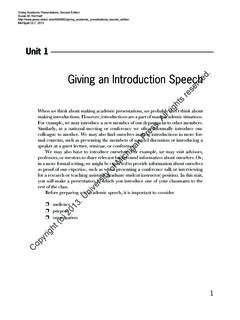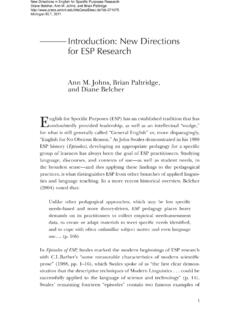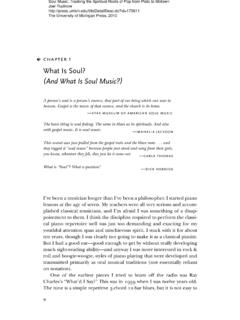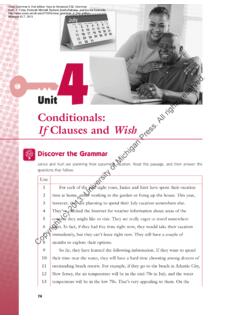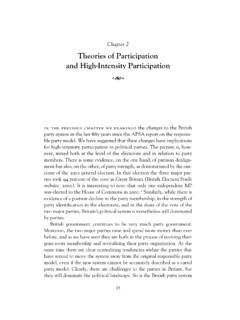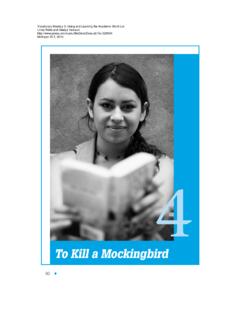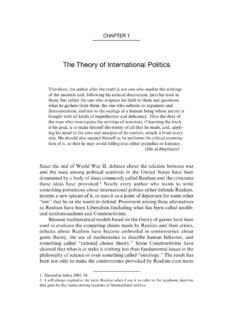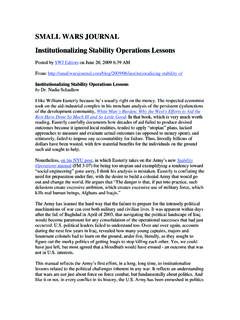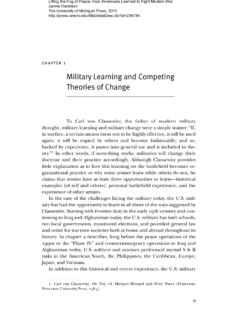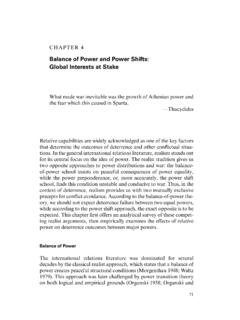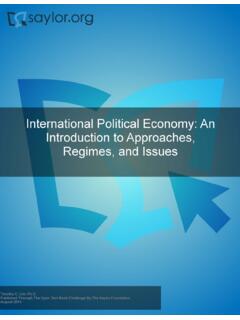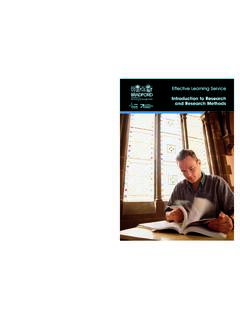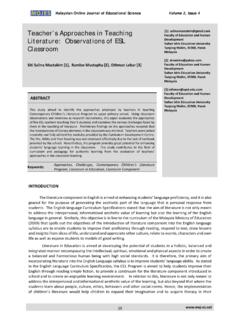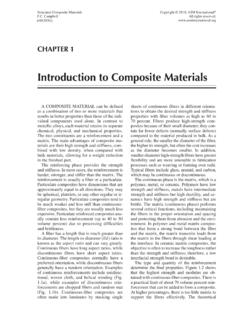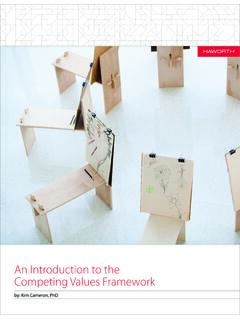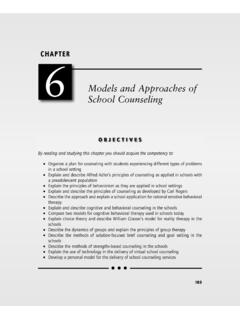Transcription of An IntroductIon to corpus LInguIstIcs
1 Using Corpora in the Language Learning Classroom: corpus LInguIstIcs for Teachers Gena R. Bennett Michigan ELT, 2010. Part 1. An IntroductIon to corpus LInguIstIcs Using Corpora in the Language Learning Classroom: corpus LInguIstIcs for Teachers Gena R. Bennett 2 Michigan Using ELT, 2010. Corpora in the Language Learning Classroom The principles of corpus LInguIstIcs have been around for almost a century. Lexicographers, or dictionary makers, have been collecting exam- ples of language in use to help accurately define words since at least the late 19th century. Before computers, these examples of language were essentially collected on small slips of paper and organized in pigeon holes. The advent of computers led to the creation of what we consider to be modern-day corpora. The first computer- based corpus , the Brown corpus , was created in 1961 and comprised about 1 million words. Today, generalized corpora are hundreds of millions of words in size, and cor- pus LInguIstIcs is making outstanding contributions to the fields of second language research and teaching.
2 What Is corpus LInguIstIcs ? So what exactly is corpus LInguIstIcs ? corpus LInguIstIcs approaches the study of language in use through corpora (singular: corpus ). A corpus is a large, principled collection of naturally occurring examples of language stored electronically. In short, corpus LInguIstIcs serves to answer two fundamental research questions: 1. What particular patterns are associated with lexical or grammatical features? 2. How do these patterns differ within varieties and registers? Many notable scholars, have, of course, contributed to the development of mod- ern-day corpus LInguIstIcs : Leech, Biber, Johansson, Francis, Hunston, Conrad, and McCarthy, to name just a few. These scholars have made substantial contributions to corpus LInguIstIcs , both past and present. Many corpus linguists, however, consider John Sinclair to be one of, if not the most, influential scholar of modern-day corpus LInguIstIcs .
3 Sinclair detected that a word in and of itself does not carry meaning, but that meaning is often made through several words in a sequence (Sinclair, 1991). This is the idea that forms the backbone of corpus LInguIstIcs . What corpus LInguIstIcs Is Not It's important to not only understand what corpus LInguIstIcs is, but also what cor- pus LInguIstIcs is not. corpus LInguIstIcs is not able to provide negative evidence able to explain why able to provide all possible language at one time. Using Corpora in the Language Learning Classroom: corpus LInguIstIcs for Teachers Gena R. Bennett Michigan ELT, 2010 An IntroductIon to corpus LInguIstIcs 3. corpus LInguIstIcs is not able to provide negative evidence. This means a corpus can't tell us what's possible or correct or not possible or incorrect in language; it can only tell us what is or is not present in the corpus . Many instructors mistakenly believe that if a corpus does not present all manners to express a certain idea, then the corpus is altogether faulty.
4 Instead, instructors should believe that if a corpus does not present a particular manner to express a certain idea, then perhaps that manner is not very common in the register represented by the corpus . corpus LInguIstIcs is not able to explain why something is the way it is, only tell us what is. To find out why, we, as users of language, use our intuition. corpus LInguIstIcs is not able to provide all possible language at one time. By definition, a corpus should be principled: a large, principled collection of naturally occurring texts.., meaning that the language that goes into a corpus isn't random, but planned. However, no matter how planned, principled, or large a corpus is, it can- not be a representative of all language. In other words, even in a corpus that contains one billon words, such as the Cambridge International corpus (CIC), all instances of use of a language may not be present.
5 Using Corpora in the Language Learning Classroom: corpus LInguIstIcs for Teachers Gena R. Bennett Michigan ELT, 2010. Chapter 1. Principles of corpus LInguIstIcs Questions We Can Answer with Corpora Broadly, corpus LInguIstIcs looks to see what patterns are associated with lexical and grammatical features. Searching corpora provides answers to questions like these: What are the most frequent words and phrases in English? What are the differences between spoken and written English? What tenses do people use most frequently? What prepositions follow particular verbs? How do people use words like can, may, and might? Which words are used in more formal situations and which are used in more informal ones? How often do people use idiomatic expressions? How many words must a learner know to participate in everyday conversa- tion? How many different words do native speakers generally use in conversa- tion?
6 (McCarthy, 2004, pp. 1 2). For the most part, these questions don't look particularly revolutionary. We already know the answers to a lot of them. We teach the ideas contained within many of these questions every day. We can open up almost any grammar, vocabulary, conversation, or writing textbook and find the answers. Even better, we can apply our expert-user intuition to find the answers. We're intimately connected A frequency list displays to the language; after all, we speak it every day, right? An the words occurring in exercise may help here. For example, O'Keeffe, McCarthy, a corpus along with the and Carter (2007, p. 32) studied a frequency list from a 10. number of times each word appears. million word corpus and discovered that the 2,000 most fre- quent words in the corpus accounted for 80 percent of all the 4. Using Corpora in the Language Learning Classroom: corpus LInguIstIcs for Teachers Gena R.
7 Bennett Michigan ELT, 2010 1: Principles of corpus LInguIstIcs 5. words present. A mere 2 percent of the words were used repeatedly to account for 8. million words. For example, degree adverbs demonstrate the extent of a particular feature, such as thoroughly in the sentence, Her chocolate cake is thoroughly delicious. Keep this in mind, and think for a moment about these questions. XX What are some common adverbs of degree? Think of at least four. XX Give examples of ways you would use these adverbs. XX Which adverbs do you think are used more often in speaking? XX Which adverbs do you think are used more often in writing? XX Which adverbs do you think are used more often overall? You may have thought of these, among others: very My sister is very intelligent. really Listening to an in-class lecture can be really difficult. exactly Sue always knows exactly what I'm thinking. quite Frederick appeared quite surprised by the low mark on his project.
8 Completely The surprise birthday party was completely unexpected. too Working full time and going to school full time is too demanding for my schedule. Because corpora don't contain the same number From this list of adverbs, we might think of words, we can't use a simple frequency count that really is used more in speaking and to see in which corpus a word is more common. quite is used more in writing. Perhaps very For example, very occurs in the spoken portion of is used most frequently overall. the corpus of Contemporary American English The exercise used multiple adverbs of (COCA) 195,000 times and in the written portion degree: where they're used, the frequency of the COCA 198,000 times; from looking only at of use, and some examples of use. This the simple frequency count, we might conclude that very is used only slightly more in written information seems like sufficient material language.
9 But, because the written portion of the for a lesson, and most teachers would feel COCA is much larger than the spoken portion, we comfortable presenting this information in can only get an accurate comparison by calcu- class. lating how many times very occurs per million Corpora can give us information like fre- words. This is the normed count. The normed quency, register, and how language is used, counts in Table show that for every million ideas identified in the adverbs of degree words in the spoken portion of the COCA, very appears 2,543 times; for every million words in exercise. the written portion, very only appears 673 times. Table shows the frequency results This allows us to see that, in fact, very is used sig- per million (rounded to the nearest one) nificantly more frequently in the spoken portion from the corpus of Contemporary Ameri- of the corpus than in the written portion of the can English (COCA).
10 (See Appendix 1 for corpus . Using Corpora in the Language Learning Classroom: corpus LInguIstIcs for Teachers Gena R. Bennett 6 Michigan Using ELT, 2010. Corpora in the Language Learning Classroom more information on this and other corpora. COCA will also be discussed in Chapter 4.) The numbers in the Speak column indicate how many times the adverbs very, really, exactly, quite, completely, too, and thoroughly are used in the spoken portion of the COCA. The numbers in the Write column indicate how many times the adverbs are used in the written portion of the COCA, and the numbers in the TOTAL col- umns indicate how many times the adverbs are used overall. Very is the most frequently used adverb overall in the COCA, and is especially frequent in spoken language. Really is the second most frequent adverb in speaking and overall, while too is the most frequent adverb used in writing. Note that too and completely are used almost the same in speaking and as in writing.
